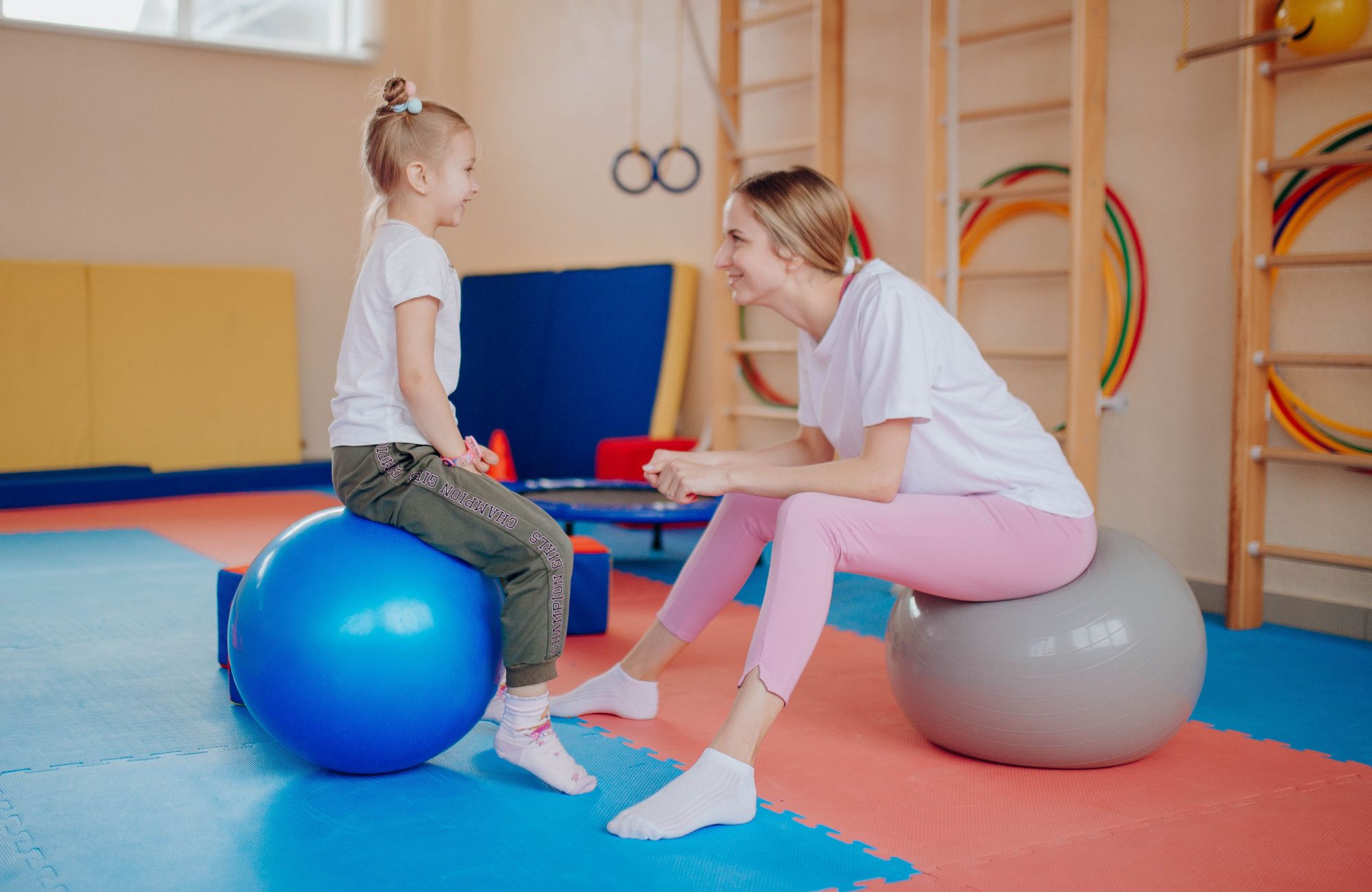


Physical therapy for kids helps children build the skills they need to move with confidence. With guidance from pediatric physical therapists, kids practice activities that improve balance, strength, and independence. Therapy also supports motor development, making it easier for children to join in everyday routines at home, school, and sports. Sessions can take place in clinics, schools, homes, or community settings, often with input from physicians, teachers, and families to create a plan that fits each child’s needs.
In this blog, you’ll learn who benefits from pediatric physical therapy, what happens during an evaluation, the treatment methods therapists use, and how parents and caregivers can support progress at home.
Physical therapy services help a wide range of patients, including infants, kids, and adolescents. Many children benefit when they show signs of:
The American Academy of Pediatrics provides resources on child development and when intervention is helpful.
The right age to begin therapy depends on the child’s condition and goals. Parents may notice concerns before a pediatrician makes a referral. Early evaluation helps the physical therapist determine if therapy will benefit the child’s ability to move, play, and grow.
At the first visit, the physical therapist looks at how your child moves, stands, and balances. They may check walking patterns, flexibility, and strength while also asking parents about daily routines. This helps the therapist understand your child’s needs and create a clear plan with goals you can follow at home and in therapy sessions.
Looking for licensed pediatric physical therapists? Flagstar Rehab connects families with skilled providers ready to support your child’s progress.
A strong treatment plan gives direction for the child and family. It covers:
Plans are tailored to each child’s unique needs. Therapists work to keep treatment practical, measurable, and tied to daily activities.
Every child’s treatment plan includes a mix of approaches that strengthen balance, mobility, and confidence. These methods are selected to match the child’s unique needs, abilities, and goals. Below are the most common strategies used in pediatric physical therapy.
Therapists guide children through targeted balance tasks such as standing on one leg, walking on a taped line, or catching balls while moving. These activities are progressive, starting simple and gradually becoming more complex as the child’s ability improves. By repeating these exercises, kids gain confidence and learn to apply balance skills in everyday activities like climbing stairs or joining playground games.
Gait training is a type of physical therapy that focuses on improving the way a person walks (their gait). Gait training helps children improve how they walk across different surfaces, including grass, ramps, steps, and stairs. Therapists break walking down into smaller parts, such as foot placement and weight shifting, to correct patterns that limit safety. Over time, better walking mechanics support greater function and allow children to participate more fully in community and school activities.
Building strength and fitness is essential for children who need to keep up with peers at school, in sports, or during daily activities. Therapists often use resistance bands, climbing walls, obstacle courses, and play-based circuits to target muscles that stabilize the trunk and lower body. Improved endurance helps kids practice longer, recover faster, and handle tasks that require energy and balance.
Coordination is the ability to move smoothly and in sequence, and therapists focus heavily on this skill. Activities like rhythm games, step sequences, or bilateral exercises encourage children to use both sides of the body together. As coordination improves, movement becomes more efficient, making it easier for children to learn new skills and participate in group play or sports.
Some children need extra support for sensory systems that affect balance, especially the vestibular system. Therapists may use swings, spinning chairs, or balance boards to safely challenge a child’s ability to adjust to movement. These activities help children improve stability, reduce dizziness, and feel more confident in active environments like playgrounds and gyms.
When stiffness or soft tissue tightness limits mobility, therapists may use manual therapy techniques. These include gentle stretching, soft tissue mobilization, or joint movements that restore flexibility. Once mobility improves, children can return to practicing balance tasks with less difficulty and greater safety.
Every child has unique needs. Visit Flagstar Rehab to find trained therapists who create safe, effective care plans for kids.
Some children experience symptoms of pain during therapy, which can interfere with progress. Therapists teach pacing, graded activity, and pain-control strategies to help kids stay engaged in sessions without worsening discomfort. Effective pain management allows children to keep practicing and achieve steady progress toward their goals.
Children come to pediatric physical therapy with many different conditions, and each requires a focused approach to improve balance and mobility. The table below highlights common conditions and the primary areas of therapy focus.
| Condition | Therapy Focus |
|---|---|
| Developmental delays | Play-based balance games, milestone-focused progressions |
| Orthopedic conditions | Recovery after sprains, fractures, or surgery; restoring stability |
| Brain injury | Rebuilding strength, coordination, and endurance after concussion or TBI |
| Neuromuscular disease | Fatigue management, adapted equipment, and gentle balance work |
| Genetic disorders | Safe movement patterns, posture, and efficient motor skills |
| Sensory challenges | Structured, predictable progressions with caregiver support |
Therapy is delivered in different settings:
Each model allows therapists to focus on goals while giving families tools they can use outside therapy.
Parents and caregivers play an active role in a child’s treatment plan. They are responsible for carrying out home exercise programs, monitoring progress, and sharing changes with the therapy team. Families also encourage practice during natural routines such as meal preparation, chores, or play, which helps integrate skills into everyday life. Many parents choose to track the child’s progress with checklists or logs, making it easier to see improvements over time. Active family involvement increases motivation and supports children in applying new skills across all areas of life.
Here are common exercises that can be practiced at home:
| Age Group | Activities to Try | Purpose |
|---|---|---|
| Infants & Toddlers | • Supported standing and reaching
• Crawling across cushions • Floor-to-sit transfers |
Build early balance, strength, and movement confidence |
| Preschool & School-Age Kids | • Walking on taped lines
• Hopping and jumping to targets • Obstacle courses with climbing, crawling, and sliding |
Improve coordination, balance, control, and playful skill practice |
| Adolescents | • Single-leg balance with reach tasks
• Agility ladder drills • Resistance walks and hop-to-balance moves |
Support strength, agility, and readiness for sports and daily challenges |
Each activity should be adjusted for the child’s condition and monitored for safety.
Therapists monitor a child’s progress using several tools, including balance scales, timed walking or standing tests, and feedback from families about independence in daily activities. These measures give a clear picture of how well the treatment plan is supporting mobility and confidence. If progress slows or new symptoms appear, the plan is revised to address the child’s unique needs and keep therapy moving forward.
Managing safety, pain, and pacing helps children stay active in pediatric physical therapy without setbacks. Any activity that causes sharp pain should be stopped immediately and discussed with the therapist. Long sessions should include rest breaks so children can recover and stay engaged. At the same time, families can adapt the home and school environments to reduce fall risks by keeping walkways clear, using stable surfaces for exercises, and providing supervision when needed. These steps allow kids to continue therapy safely while building confidence and steady progress.
When selecting pediatric physical therapy, ask:
A qualified, trained physical therapist can guide your child toward their full potential.
Therapists benefit from using structured protocols when supporting balance goals in children. The process begins with a clear evaluation and well-defined goal setting to match each child’s unique needs. A four-week progression is often developed to build balance confidence in a step-by-step manner. During care, outcome tools are used to monitor patients and make timely adjustments. Regularly sharing case notes with the broader team also helps maintain consistency across programs and supports steady progress for each child.
Physical therapy for kids plays an important role in building balance, confidence, and independence. With guidance from pediatric physical therapists, children can improve mobility, reduce pain, and gain the skills they need to participate actively in everyday activities at home, in school, and in sports. By combining structured treatment plans, home exercise programs, and support from families and caregivers, therapy gives children the tools to reach their full potential.
At Flagstar Rehab, we connect families with skilled therapists and provide access to tailored physical therapy services designed to support each child’s unique needs. Our nationwide network of licensed professionals offers flexible placements in clinics, schools, and home settings. Whether you are a parent seeking care for your child or a therapist looking for new career opportunities, contact Flagstar Rehab to schedule an evaluation or explore current job openings.
Physical therapy for kids is care provided by pediatric physical therapists to help children build balance, strength, coordination, and confidence. The focus is on improving mobility, reducing pain, and supporting motor development so children can participate actively in everyday activities at home, in school, and in sports.
Children can start pediatric physical therapy as early as birth if there are concerns about developmental delays, injuries, or medical conditions. Infants, toddlers, and adolescents may all benefit depending on the child’s condition and needs. Early evaluation helps therapists determine the right starting point.
The best type of therapy depends on the child’s unique goals and diagnosis. For some, balance and gait training are the focus. Others may need manual therapy, strengthening, or targeted home exercise programs. A trained physical therapist creates a personalized treatment plan that matches each child’s needs.
Physiotherapy for kids is another term for physical therapy for kids. It involves the same licensed therapists providing physical therapy services to improve a child’s ability to move, grow, and reach their full potential. The goal is to promote independence and support healthy progress in daily activities.